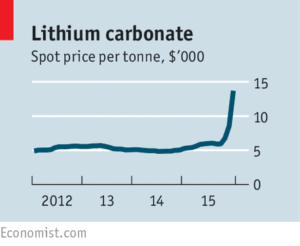When I first heard about LOR, I thought it meant Lord of the Rings, but no, the topic was on Lazard World Dividend & Income Fund(LOR).
I got this email from a reader:
I love your blogs. Please tell me what to think about an odd stock – LOR. They make money from high dividend stocks AND from some sort of forward contracts involving emerging market currencies.They had a 25% yield last year but are extremely volatile ( and I don’t know why!). They have a lot of institutional investors and it looks like a good dividend pick but I don’t understand how reliable the currency contracts are. Could you do an analysis of LOR?
I’m not exactly a stock picking expert, but I’ll give it a shot. First of all I looked for LOR on Yahoo! Finance to see what it meant. I got the name of the company, the stock price graph but not much other info. That’s because it’s not a stock, but rather an ETF. Ah ha! That explains the high dividend, since I don’t know of any company that is so generous with their dividends.
Accordingly, I headed over to ETFconnect, which is a great site for finding information on ETFs. I see that its in the category of “global equity” which means it invests in world-wide stocks, just the kind of thing you’d expect from its name!
It states their investment objective:
The Fund seeks total return through a combination of dividends income and capital appreciation. The Fund may pursue this objective through a world equity strategy and a short-term emerging markets and debt strategy. The Fund may invest substantially all of its net assets in between 60 to 90 world equity securities that are financially productive and high dividend yielding. It seeks to enhance income through exposure to short-term emerging market forward currency contracts and other emerging markets debt instruments, limited to 33.3 percent or less of the total leveraged assets of the Fund, which will provide exposure to emerging market currencies.
The first part seems pretty straight-forward, but I’m not too sure what the last part entails. But at least they’re not leveraged 10 to 1 on some Subprime Real-estate Mortgage Backed Securities (RMBS) & Collateralized Debt Obligations (CDOs)! Being overleveraged is what caused Bear Stearns’ Hedge funds to collapse last July.
I also see that it’s currently trading at an 8.5% discount to its Net Asset Value (NAV). This means you can buy the basket of its shares for less than what the shares currently trade for! The current dividend yield is reported to be 8.43%. That’s strange because Yahoo! finance reported it to be 25%, a fact that I verified on Google Finance by looking at the distribution in the stock chart. It seems that in addition to the dividends, there were long and short term capital gains distributions in December 2007, which boosted the yield.
While this isn’t a bad thing in any way, one shouldn’t buy LOR expecting to see a similar 25% yield in the future. If you’re buying it for the dividend, you should expect to receive 8.5% and be happy with it. The only concern I have is whether or not that dividend is safe.
The ETFconnect site informs us that the fund is diversified by invested in the US (35%), th UK(23%) and other countries (42%). While it doesn’t say which other countries, looking at its top holdings we see companies like Taiwan Semiconductor, ENI and Tesltra, so we know its investing in South East Asia, Brazil and Australia. I like that global diversity.
It also seems to be diversified across various industries like finance, telecom, energy, materials, consumer staples, and so on. However, from the mix of industries it’s invested in, 32% is in the Financial Sector. That I don’t like at all. Considering that Bank of America, HSBC and Citigroup are also featured in its top holdings, I’d say thats a little to much for me. While the stocks in finance sector are currently rising on the backs of the Fed’s rate cut, I expect this joy to be short lived. And I still haven’t seen any information on its’ currency trading, debt-instrument contract or whatever it was.
So I guess it’s time to look at the company’s website, Lazard Asset Management. Here we get a little more insight to the investment objective:
*The Fund will invest substantially all of its net assets in between 60 to 90 world equity securities that are financially productive and high dividend yielding.
*It seeks to enhance income through exposure to short-term, emerging market forward currency contracts and other emerging markets debt instruments (limited to 33.3% or less of the Fund’s total leveraged assets), which will provide exposure to emerging market currencies.
These two strategies are complementary, with historically low correlation to one another, which may reduce volatility.
They may have a low correlation, but as we saw with LTCM and the recent global stock market correction, all markets are correlated to the downside. I’m highly skeptical of these statistical models that tout low correlation since they always seem to fail at inopportune moments. But at least their leverage doesn’t seem excessive. At least they’re honest and inform us that
There can be no assurance that the Fund will meet its investment objective.
But the rest of their site is actually quite informative. We already know that the stock portion of the fund is diversified across various countries, industries and capitalizations so I’ll skip over that part. But we haven’t seen much info on the currency & debt portion.
The Fund’s emerging market currency and debt strategy will also be broadly diversified across countries and regions, offering the potential for portfolio diversification- with the possibility of credit and duration protection and limited interest-rate sensitivity.
Not really sure how they’re implementing this strategy, but if it works, it would be pretty useful in current economic conditions!
They also have an interesting snippet about their dividend strategy too.
While the Fund’s equity investments are not chosen for yield alone, they will generally include the highest dividend-yielding stocks on Lazard’s equity platform, as well as a selection of stocks that may potentially have significant dividend growth. This is important because:
*Typically, dividends are real earnings, not hoped-for earnings based on the potential, future growth of a stock. They also offer the potential for stable income.
*The 2003 tax bill significantly lowered the U.S, tax rate on qualified dividend income of U.S. taxpayers.
Investing in companies with a track record of long term dividend growth is a sure fire way to beat the index averages [source: The Future for Investors by Prof. Siegal]. Investing for tax savings is not something I generally consider. First the investment has to make sense. Then you look at the taxes. If you’re so rich that you’re really worried about taxes, then maybe tax-free munies are the best route for you.
Finally, there seems to be some information on the currency trading aspects.
The Fund’s unique leveraging strategy allows greater flexibility, risk management, and economic efficiency. To enhance the income potential for investors, the Fund intends to employ financial leverage, initially up to approximately 33 1/3% of total assets, by investing in forward currency contracts and/or borrowings. Leveraged assets will be used for investing in emerging market currency or debt instruments.
It should be noted though, that the Lazard World Dividend & Income Fund, does not seek to profit from utilizing a leveraged spread-play. That is to say, the Fund is not borrowing at the short-end of the yield curve in order to invest at the longer-end of the yield curve (and profit from the spread). On the contrary, the leveraged portion of the Lazard World Dividend & Income Fund invests in very short duration instruments (typically, less than 12-months), and instead seeks to profit from accessing the high yields available in emerging market local currency debt.
Using leverage is a speculative investment technique and involves certain risks.
While its commendable that they aren’t borrowing short-term and lending long-term (remember the RMBS & CDOs I mentioned?), I get the feeling that they’re trying to profit from the carry-trade. Of course, I’m not 100% certain that’s what they’re doing, but it definitely sounds like that to me. With the Swiss franc nearly at parity with the US Dollar and the Yen up 26% in the past year, it strongly looks like the carry-trade is unwinding. In fact, they could start losing money on these kinds of trades.
To conclude, I think this is a very interesting fund. I would be amazed if they could continue to deliver 25% annual dividend yields, but 8-9% definitely seems achievable.
However, I’d look at ALPINE DYNAMIC DIVIDEND FUND (ADVDX) and even American Capital Strategies (ACAS) before I allocated any funds to LOR. Note, I’m not recommending either of the 2, I’m just saying I’d take a look at them before I made any decision.



